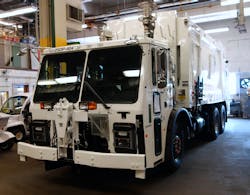NEW YORK. It collects some 9,000 tons of refuse and recyclables a day, but that’s just one of the jobs carried out by the New York City Dept. of Sanitation (DSNY) fleet of 2,500 heavy-duty collection trucks. They serve as protection for presidents and popes, carry people to safety during floods and hurricanes, lead recovery efforts after disasters and, perhaps most importantly, marshal their full strength within an hour to clean the city streets of snow even when it hits record levels like the 30-inch snow storm last winter.
In addition to the heavy and varied workload, DSNY is expected to lead New York’s green fleet efforts by pushing for clean fuels and technologies from its suppliers while also serving as a test bed for anything that holds promise. With some 19,000 mi. of roadway within city limits, DSNY vehicles “drive every street every day,” says Dept. of Sanitation Commissioner Karen Garcia. “We drive more every day than anyone else, so we’re a big player in the city’s clean fleet initiative.”
It’s a big fleet by any standards. In addition to its 2,500 refuse collection trucks – almost all Mack LR low-cab forward models – DSNY’s heavy-duty fleet includes salt spreaders, dump trucks, pump trucks, heavy wreckers, day cab tractors and other miscellaneous specialized vehicles, again almost all Mack’s, either Granite or Titan conventionals. Add in the pickups and medium-duty chassis, the cars, and vehicles from NY’s Board of Education and Dept. of Environmental Protection, and DSNY is responsible for maintaining and fueling some 7,000 vehicles.
Today all of its diesel powered vehicle run on B20 biodiesel blend, over half staying on the high biodiesel blend even in the winter. The new diesel emissions systems have also gone a long way in helping the fleet meet its clean fleet goals, says deputy commissioner Rocco DiRico, but the fleet continues looking for even better solutions, whether it be new fuels, alternative powertrains or new technologies.
Because of the requirement that it fuel the entire fleet within an hour in the event of a snow emergency, natural gas hasn’t proved practical especially since CNG fueling stations require too much space in such a dense city, according to Commissioner Garcia. Right now the fleet is about to undertake initial testing with renewable diesel, which is not only better in terms of greenhouse gas emissions, but can be used as a complete replacement for diesel, not just as a 5 to 20% blend.
DSNY is also exploring with Mack a test of DME, a liquid fuel that can be produced from waste materials and used in simple compression-ignition heavy-duty engines without complicated aftertreatment systems.
On the alternative powertrain side, the fleet is currently running 49 hydraulic hybrid and three electric hybrid refuse trucks. “They’re doing OK, but we’re not seeing the 30 to 40% fuel economy improvement we expected,” says DiRico. “We’re getting more like 10 to 15% in our operation.”
However a simpler stop/start technology shows promise. A test with one truck is delivering that 30 to 40% economy improvement “with no extra weight and minimal cost,” DiRico says. “It looks like the closest thing to a frontline silver bullet we’ve found for our operations, so we’re going to retrofit some more trucks soon. I hope it lives up to expectations, but we’ll just have to see.”
DiRico adds that with a fleet the size of DSNY “even smaller baby-step technologies all add up” in the push for a cleaner fleet. One such technology he’s like to see eventually is replacing refuse truck hydraulics with electrical systems. Remote diagnostics, GPS tracking and even simulator training for plow operators are other technologies DSNY believes hold promise.
While DSNY works closely with Mack Trucks and other suppliers to meet its clean fleet goals without jeopardizing its mission, it has also invested heavily in the tools to independently quantify and verify its progress. At its Central Repair Shop, which covers six floors and has more square footage than the Empire State Building, the department has installed an $18-million heavy-truck dynometer in a controlled atmosphere building. It can run its largest trucks through 35 duty cycles, including a specific NYC refuse work cycle, according to Spiro Kattan, deputy director for the clean fuels and technologies division.
“We can quantify and qualify fuels and technologies by measuring before and after emisisons coming out of the tailpipe,” says Kattan. “We’ve even done testing for the Environmental Protection Agency.”
About the Author
Jim Mele
Jim Mele is a former longtime editor-in-chief of FleetOwner. He joined the magazine in 1986 and served as chief editor from 1999 to 2017.
